Mental Layers: Beliefs

Each of us have a very large collection of beliefs about how the world works. This goes a lot further than any religious or spiritual philosophies we may have. Our beliefs extend much further and cover our opinions about any and all different aspects of life. Beliefs and opinions are roughly synonymous, but beliefs also include decisions we've made about the world, about other people, about situations, and about ourselves.
We form a small portion of our beliefs as adults, often during pivotal moments of our lives. However, the great majority of our beliefs are actually inherited from those around us when we were young. Parents, other family members, teachers, doctors, neighbors and others we encountered when we were young, gave us most of our beliefs.
While our collection of beliefs forms a large portion of our personality, the Belief layer of the mind is a unique layer within the mental layers hierarchy. It spans the boundary between where the conscious and subconscious minds overlap. Recall from our conversation about mental states that the alpha state is that range of brainwaves where the conscious and subconscious mind overlap. The beliefs layer is the mental layer where that overlap occurs. This is important because this gives us both conscious and subconscious access to our beliefs.
Let's take a closer look at this particular layer: what it is, how it expresses itself, how it impacts our lives, and how we can change beliefs that no longer suit us.
How Beliefs Reveal Themselves
Beliefs are odd creatures. We are strongly aware of some of them. We are partially aware of others, and completely oblivious about the rest. But beliefs will demonstrate themselves in a variety of ways:
Consciously, we hear our beliefs speak when we say things like:
- I believe that (something) is true, false, right, wrong, etc
- I know that (something) is true, false, right, wrong, etc.
- I feel that (something) is true, false, right, wrong, etc.
- I'm afraid that....
- I'm convinced that....
- I accept that....
- I'm sure that....
- I'm positive that....
Those might seem like everyday comments, and they are. They are how our beliefs layer expresses itself on everyday issues.
Our beliefs show themselves in other ways too. When our actions and decisions align with our beliefs:
- we are at peace with our choice
- we feel like we have been "true to ourselves"
- we are convinced we made the "right" or "only" possible decision
Conversely, when our actions and decisions go against our beliefs:
- we are uneasy or feel conflicted
- we have a vague feeling of unease regarding a decision, action or situation
- we have an unexplained difficulty taking action on a decision, situation or goal, often labeled as procrastination
- We experience a pattern of self-sabotage in a certain category of life, or regarding a particular project, goal or task
When questioned about our feelings, sometimes we can describe or explain why we feel the way we do. However, it usually doesn't take much for us to start feeling defensive about our beliefs. We often don't recall where they came from but they feel absolute. We rarely want to change them, and we have no idea how to change them even when we want to.
How the Beliefs Shape Our Lives
When our beliefs are in alignment with our other mind layers, things run smoothly. We set goals, we do the work to achieve them, and we enjoy the success of reaching another goal. Then voila! The cycle starts over with new goals and more forward progress. Our movement through the various stages of any given project seem straightforward, and relatively stress-free. Yes it takes effort, but we can clearly see the benefits of reaching our goal. Whatever effort we exert seems 'worth it' to reach those goals.
That's how things are supposed to work. When our identities, values and beliefs are all in alignment, that's how it does work.
How Beliefs Can Create Problems
One major frustration for many people is that they have contradictory or conflicting beliefs. This means that Belief A tells them to do X, while Belief B tells them to do Y. When faced with choosing between X or Y, a person will be conflicted, indecisive, or choose one then actually do the other. This can be maddening to watch, and even more maddening to experience first-hand. Progress towards our goals comes to a screeching halt, and we're not sure how to get around the obstacles we've hit.
To be fair, everyone hits obstacles at some point. To paraphrase Napoleon, "no battle plan survives contact with the enemy." In other words, we can come up with the best possible way to move forward with any given project, but we'll invariably hit some kind of speedbump. Sometimes when a problem comes up, we know exactly what to do and how to respond. Other times, however, we're at a loss. None of our convictions or expectations seem to be holding up under pressure, and we're not sure what else to do. Or, worse, our convictions and expectations are playing out just as they always seem to: with failure. That is when many people decide they are "broken" or unfit in some way, or perhaps "fated" to never achieve what they hope to achieve.
The good news is that beliefs can be changed. Sometimes we'll already know which belief needs to change. If we created that belief as adults, via some decision or choice, we can make some other decision or some other choice. However, when we've inherited beliefs from our families, and/or those beliefs were created when we were very young, it can be a bit more difficult. It seems like we "must" do things a certain way, or make a certain choice, or take a specific action. When some vague conviction is guiding our choices, and we describe it in terms listed above, that's when we know that we're dealing with a belief still buried in the subconscious. That's when a coach, hypnotist or NLP practitioner can help.
Change Beliefs, Change Our Lives
Recall that the Beliefs layer spans the boundary between the conscious and subconscious. That gives us several options for changing unconstructive, unwanted or dysfunctional beliefs. One immensely powerful way to change a limiting of dysfunctional belief is to ask ourselves the following series of questions. Because beliefs exist partially in the conscious, we can do this on the conscious level. When we ask ourselves these questions consciously, in the order listed below, the answers will come from the subconscious. That gives us the information we need to move onto the next step in the process.
NOTE: it can be very helpful to write down each answer as it comes to us. Avoid judgment, evaluation and criticism. The answer may not make much sense at the time, and in fact it may sound downright absurd. That's OK. Just write it down, and move on to the next question.
Here are the questions, in order:
- What is the belief? You may not need to ask this, because you may already know what it is. Just go ahead and write it down.
- Why do I believe that? In NLP, we don’t usually ask “why”, but this isn’t a strict NLP series of questions. We’re looking for the root cause of the belief, the source. If you can find a way to ask this question without saying why, do so. For instance “How did I come to believe that?” or “When did I decide that?” or “where does that belief come from?”
- What am I afraid would happen if I don’t believe it? Another way to ask this is “what is that belief protecting me from?” THIS IS THE BIG QUESTION. Lots of folks aren’t really aware of what they’re afraid of per se. Most of our beliefs from childhood are straight out of our parents’ mouths, and weren’t based in reality to begin with. Alternately, this particular fear is based on something that happened many years (or generations) ago, and is no longer relevant. Once we ask this this question out loud, it helps us start to work through not only the source but also usually how it’s not a realistic concern.
- Do I believe that outcome? Usually by this point the belief is already either significantly changed, or gone.
- Whose belief is that? This is another powerful question. Most of our most powerful beliefs come from our parents (or even generations prior to our parents), and we’ve never actually thought about them. This will give us even more distance and objectivity about our belief. Many times when asking ourselves this question, we'll instantly recall not only who said it, but what the context was. Often, something that may be true in a certain context is taken to be true in all contexts. By asking ourselves this question, we can further weaken our belief's hold on us under our current circumstances.
- What can I choose to believe instead? A belief that will be my very own creation, and will empower me? Now we’re going to switch things up and give ourselves permission to create a healthier, more constructive alternative. At this stage we are literally creating a better future for ourselves, rather than being chained to the past. Make sure this belief works for you instead of against you, and that you are perfectly satisfied with it. To be sure a new belief is "good" for us, it is helpful to review the Presuppositions of NLP and Prime Directives of the Subconscious, as reminders of how to create empowering, healthy, constructive beliefs for ourselves.
A lot of limiting beliefs are like cockroaches. They’ll stay and proliferate as long as no one shines any light on them. As soon as we start shining a light on them, and deprive them of cover, they leave. Further, we can replace those limiting beliefs with new ones, custom-tailored to what we want them to be. Those beliefs, in turn, will help pave the way to the life that we want.
NOTE: many people have a hard time putting faith in the answers they come up with, because those answers feel "made up". That's because they're coming from the subconscious. The imagination also resides in the subconscious, so most of us are familiar with the "voice" of the imagination. But when we're asking ourselves questions like this, the first answer that comes to mind is the most accurate answer our subconsious can give us. That's the answer to work with.
Working with a Coach or NLP Practitioner
Sometimes, the task of asking ourselves guided questions can seem a bit intimidating. That's the time to work with a qualified success coach or NLP practitioner. The coach or practitioner can talk with you about the work you've done so far, and help you replace limiting beliefs. Also keep in mind that a coach or NLP practitioner will have additional techniques to deploy if needed, as well as an outside perspective which can sometimes determine the limiting belief so that you can then replace it with something better.
If you have some limiting beliefs that you'd like to get rid of, and you'd like to work with a qualified success coach, contact me and we can set up an appointment to discuss your needs.
|
Shopping Cart |
|
Contact Me For Help Reaching Your Goals

When you're ready to move forward, push through obstacles and make real progress towards your goals, Contact Me today.
New Products and Services Request Form
Do you have a product or service request that you don't already see listed here? I'd love to hear your ideas! Please feel free to either Contact Me or fill out my new Product and Service Request Form.
Thanks for your suggestions!
